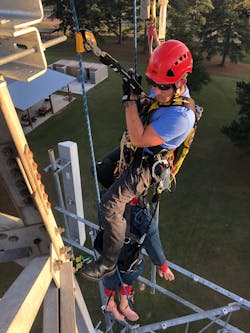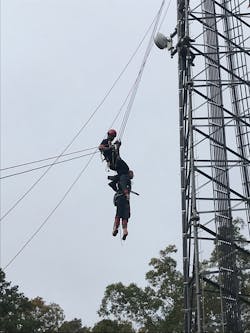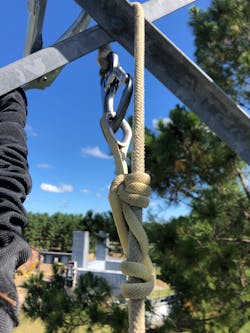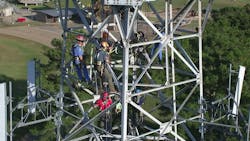Wireless Estimator cites eight fatalities on tower sites in 2019. As recently as 2013, there were 14 such deaths. Upticks in accidents and fatalities usually correlate to big construction or technology rollouts, such as the 3G, 4G and possibly the current 5G upgrades that are underway. Some years, studies rank tower climbing/installation as the most dangerous job in the United States.
Further, these statistics only reflect fatalities in the cellular communication industry. Accidents, near-misses and rescues occur in significant volume themselves.
The tower rescue discipline is gaining traction, and it’s beginning to get a standalone foothold in fire department special operations (spec-ops). It first was acknowledged in the 2014 edition of NFPA 1670: Standard on Operations and Training for Technical Search and Rescue Incidents and then in the 2017 edition of NFPA 1006: Standard for Technical Rescue Personnel Professional Qualifications in regard to the job performance requirements
Tower rescue and the techniques that are used aren’t limited to the cellular communication towers that come to mind for most people. The tower rescue discipline and techniques typically apply to monopoles, guyed towers, radio and TV transmission towers, water towers, billboards, stadium lighting and cranes.
The name of the game in tower rescue is light and fast, 100 percent tie-off, and a highly skilled and fit team. It has many unique characteristics, but the focus here is on two of the big takeaways that were eye-opening for our staff when we set out to teach others:
- The nonionizing radiation or radio frequency (RF) and other hazardous energy isn’t as big of a threat as most firefighters imagine
- The equipment that’s needed is more specialized and unique than the standard fire department rope rescue kit
When an uninformed rescuer stands at the base of a cellular tower and takes in the vast array of coaxial cable, generators and wires, he/she might not be able to consider anything but how all roads lead to getting zapped, fried or otherwise cooked. As a matter of fact, it isn’t that bad.
The majority of cellular and radio transmission towers use low-energy along with nonionizing radiation frequencies between 3MHz to 300GHz, which can cause induced currents, tissue heating, metallic taste in the mouth, general flu-like symptoms and targeting of specific internal organs, but the exposure and symptoms are acute and rarely have lasting effect.
Most access and rescues can be achieved with minimal-to-no exposure to this nonionizing radiation. Nevertheless, serious rescue teams should invest in personal RF monitors for their members, and those who are serious about tower rescue should take a course in RF awareness.
Each tower site might have as many as four cellular carriers. The hub of each antenna has signage that rescuers can use to call emergency numbers to advise of a rescue and request a transmission shutdown. Call each number and advise to de-energize. Additionally, tower workers who are on scene can serve as sources of information and of advice regarding the energy hazards and whether the antennas are transmitting.Equipment
The fire service spends an unfortunate amount of time training on the highline family, litter scoops and artificial high directionals (AHDs), despite the fact that the fundamentals of getting access and making a rescue at height aren’t mastered.
The typical fire service mode of operation for rope rescue is a top-down approach, in which the patient is located below on a ledge, platform, cliff bottom or similar location. In these instances, it is practical to transport bulky and heavy equipment caches to a point above the patient to initiate the rescue. This means that two or three rescuers must climb with all of the gear to safely perform the rescue. This isn’t the case with tower rescue.
Industry doesn’t concern itself with or recognize NFPA standards for work at height. The standard that’s used in industry is ANSI/ASSE Z359: Fall Protection & Arrest Standard and ANSI/ASSP A10.48 Standard: Criteria for Safety Practices with the Construction, Demolition, Modification and Maintenance of Communication Structures, which Occupational Safety and Health Administration (OSHA) almost exclusively cites in its safety standards, literature and citations. Parts of NFPA 1983: Standard on Life Safety Rope and Equipment for Emergency Services are stronger than ANSI, and parts of Z359 aren’t addressed by NFPA.
In the tower realm, ANSI-certified equipment and its compliant use is much more important than any NFPA standard. Not everything in my tower rescue kit is Z359-certified, just as not everything in a rope rescue kit is NFPA-certified. Compliance and differentiation between fall arrest and work-positioning systems is of the greatest importance.
Fall arrest is industry speak for the belay or the safety catch. In tower rescue, these are in the form of cable climb systems, Y-lanyards and fall-arrest lanyards. Issues of compatibility include anchor strength, use and free-fall height. Work positioning is what firefighters would consider their mainline or rappel line. In the tower setting, this might be a rope system or a short rope or chain lanyard. The difference is that, to maintain 100 percent tie-off compliance, the technician must be connected to fall arrest 100 percent of the time but only supported by work positioning as needed.
Fall-arrest lanyard: A fall-arrest system typically is worn on your dorsal connection and allows you to move off of the cable climb and around the tower. It is one of your most important tools. ANSI certification is a must. You want a Y-lanyard to be able to grab around large structural steel while remaining as light as possible. Tieback lanyards allow the connector to be threaded around and over a large steel member and clipped back to the middle of the lanyard. Tiebacks are a huge advantage.
Also an important consideration: certified fall distance. We prefer the flexibility of lanyards that allow for greater free fall. These allow for 12 feet and technically can be placed at our feet.
Cable fall arrestors: The high cost of a good cable fall arrester will come as a shock, despite the fact that there still is much room for improvement in these devices.
Nothing from your rope kit will substitute, so forget about mechanical rope grabs or Prusiks.
Cables on elevated structures have a 5/16- or 3/8-inch diameter. One or two models that are on the market accommodate both sizes. Make sure that your arresters are compliant with the cable that’s in your area. Cable climbs never should be used for rest or work-positioning.
Work-positioning lanyard: This is a piece where you can cut corners and save money, but it isn’t worth it. Tower technicians seem to prefer the Grillon-style lanyard hands down. It can be used single-point off of the ventral attachment on the harness or two-point from the work-positioning side rings. The lanyard usually is 2–3 meters long and has a smooth personal descender for vertical movement. The attachment is made in numerous configurations.
Rope access kit: This gear is in line with what progressive spec-ops teams run. The rope needs to be suitable for the job. (The average tower height is 300 feet; the size of the rope should be 7/16 inch.) The harness should be a full-body type that’s comfortable, breathable and light and have at minimum two ascenders, cowstails, a food loop(s) and a 7/16-inch descender of choice. The standard kit should include a self-trailing back-up device, such as an ASAP lock for an access line or second rope system.Training
The time and skill that’s involved in tower rescue demonstrates that this arena isn’t for the throngs of spec-ops members. A good way to break it down in manageable pieces is to sort out the wants versus the needs.
Needs: The tower rescue technician must be a super-dialed-in Rope Rescue Technician. Confined Space and HazMat Technician training helps to ensure understanding of lockout/tagout, nonionizing radiation, control zones, monitoring and exposure limits. The capstone of this collection of training is the Tower Rescue Technician course. This course should include separate or standalone RF awareness training and certification. The course should have all of the tower access and rescue basics. However, a true technician course will address multi-pitch problems, lead climbing, and three-dimensional movement around the tower and antenna booms.
Wants: If possible, take a competent tower climber/rescuer course from a reputable tower training organization. These courses help first responders to understand what training and recertifications are used in the tower industry. You will find that the spec ops firefighter is fluid at rescue systems, but the tower hand excels at climbing and at the use of his/her unique tower harness and kit.
The last want—and it’s a big one—is take a rope access course. These are the best industry-focused training courses for all things working in suspension on rope. They are expensive but typically finish with a third-party certification session.
Special considerations
There are many nightmare/worst-case tower rescue scenarios (towers that lack climbing pegs or engineered anchors; towers that are in the range of 1,000 feet or taller; elevators whose safety systems were bypassed, etc.).
The first tactic to address these scenarios is to deprive the “enemy” of the element of surprise. In other words, preplan these possible offenders. There are many tools for this, but we find the following websites to be very helpful (the locator sites can help with location, owners, and height):
- americantower.com
- fcc.gov/wireless/support/antenna-structure-registration-asr-resources
- sbasite.com
- wirelessestimator.com
The tower structure has an owner, and the owner is responsible for ensuring a safe workspace and that rescue is achievable. Contact the owners of installations that pose heightened risks or appear atypical/noncompliant. There might be some serious access limitations. Bottom-up multi-pitch is like doing a big wall rescue on the El Capitan rock formation: serious business. Lead climbing for rescuers on towers is a quagmire that OSHA and NFPA want no part of, but there are viable methods. Some transmission towers and 1,000-footers might be better serviced by a state or local helicopter search and rescue team (HSART).
A four-pronged attack
Tower rescue, which incorporates many more types of elevated problems than just cellular sites, is a high-risk/low-frequency call. That said, the increasing amount of work at height, as space is limited and people build up, is having a corresponding increase on call volume. This discipline requires exceptional individuals who have specialized equipment and extensive training. Without all three elements, teams certainly will encounter capability gaps. To capture that extra edge, preplan your biggest problems and practice your techniques for both access and rescue.
About the Author

Russell McCullar
Russell McCullar is a senior instructor with the Mississippi State Fire Academy, where he manages NFPA 1006 rescue programs. He serves as a rescue specialist and technical search specialist with FEMA’s Tennessee Task Force 1. McCullar instructs other rescuers around the country, consults with his company, Craft Rescue, and volunteers as an instructor for the National Cave Rescue Commission. He is an EFO graduate and holds a master’s degree in homeland security and a bachelor’s degree in business administration.



